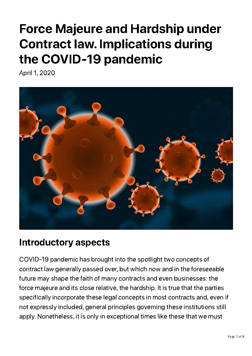- About Us
-
Expertise
- Banking & Finance
- Capital Markets
- Competition & Antitrust
- Corporate & Commercial
- Data Privacy
- Employment & Pensions
- Energy & Natural Resources
- Gambling & Betting
- Healthcare & Pharmaceuticals
- Insurance
- Intellectual Property
- International Arbitration
- Litigation
- Mergers & Acquisitions
- Project Finance/PPP, Concessions & Infrastructure
- Public Procurement
- Real Estate
- Restructuring & Insolvency
- Sports Law
- Tax
- Telecommunications, Media & Technology
- Transports & Logistics
- White Collar Compliance & Defense
- Our team
- Careers
- Publications
- News and Press
- Contact
Legal Update
COVID-19: Mergers & Acquisitions. Implications
Corporate & Commercial
 Force Majeure and Hardship under Contract law. Implications during the COVID-19 pandemic
Force Majeure and Hardship under Contract law. Implications during the COVID-19 pandemic
Introductory aspects
COVID-19 pandemic has brought into the spotlight two concepts of contract law generally passed over, but which now and in the foreseeable future may shape the faith of many contracts and even businesses: the force majeure and its close relative, the hardship. It is true that the parties specifically incorporate these legal concepts in most contracts and, even if not expressly included, general principles governing these institutions still apply. Nonetheless, it is only in exceptional times like these that we must really understand how can the force majeure and hardship save one from defaulting under contracts or otherwise failing the business.
As in so many instances, the truth is somewhere in the middle. Because unless the parties decide to entirely de-activate the force majeure and hardship clause, when the outcome is pretty clear, anticipating the unpredictable is hard to do. No matter how the force majeure or the hardship were crafted or meant to apply at the execution of the agreement, they will eventually come down to the particularities of each extreme event unfolding.
We do not intend to analyse the purely legal particularities and other theoretical coordinates of force majeure and hardship, these have already been largely addressed in the flows of doctrine generated by the COVID-19 pandemic. Instead, we run through the hottest areas under various private law contracts, anticipating the topics around which parties will debate on.
General takeaways
Force Majeure and Hardship
Force Majeure is:
- A legal cause for exoneration of one’s liability, leading to suspension of the contract, adjustment of obligations or even termination of the contract.
- A concept of private interest. This means that parties can amend it conventionally, even to the point that force majeure is entirely suppressed from the spectre of a contract.
- Present by default, as a mere effect of the law, even when the agreement bears absolutely no reference to it.
- Complementary with other legal provisions applicable by default, going hand in hand with the parties’ obligation to act in good-faith, as well as with the creditor’s obligation to mitigate damages.
Force Majeure is not:
- Applicable in bulk. Instead, one must assess it on a case by case basis, by reference to each contract and each type of obligations, because: (i) even within the same contract, certain obligations may be impossible to perform, while other may be not and (ii) while it can be applicable to one contract, it does not necessarily apply to the next contract, down or up the chain.
- Applicable automatically, meaning that the interested party must effectively invoke it and be ready to prove it. Ultimately, whether the force majeure occurred or not may be subject to dispute in court, being understood that misusing the force majeure concept may lead to payment of damages.
- Static, meaning that given the industry and the development of the initial fact, events which did not qualify as force majeure can be reconsidered at some point.
- (Generally) applicable to obligations concerning generic goods. The greatest impact here is on obligations to pay money, because encountering a financial distress cannot, by itself, qualify as force majeure.
Hardship
- Has many of the characteristics of the force majeure described above, but intervenes in less dramatic circumstances, when a party’s obligations become excessively onerous.
- If successfully invoked, it may trigger the adjustment of the contract, its suspension or other facilities aimed at rebalancing parties’ positions. Parties’ failure to amiable renegotiate the contract leaves room to the debtor to seek adjustment of the contract in court. Termination of the contract seems not on the table, at least not directly.
Specific takeaways
M&A contracts
- The contracts which have not reached closing yet are subject to the greatest impact.
The main areas under review would be:- Pricing – various pricing structures may suffer or become out of reach, such as earn-outs. As well, achieving certain financial targets, relevant for price adjustments, could now become irrelevant or deceitful (due to both extraordinary increases, for some business, or severe shortfall for others).
- Conditions precedent – there are factors which could delay or actually make impossible the fulfilment of conditions precedent. For example, merger control authorities could bluntly suspend the filings or ongoing assessments[1], while banks could deny change of control formalities or granting the required financing.
- Material Adverse Change – parties include here various cases which allow one to terminate the contract (e.g., loss of material revenues or business is often such a case), but sometimes even the plain and simple force majeure is included here.
- Longstop date – plenty of factors as well which could make the longstop date occur, especially stemming from those conditions precedent requiring certain actions from authorities or third parties.
Financing contracts
- Perhaps one of the most severely affected type of contracts, due to the following reasons:
- Force majeure and hardship are usually not applicable to obligations concerning generic goods, such as the obligation to pay money. This principle is reenforced in the vast majority of financing agreements, with parties expressly excluding all force majeure and hardship.
- Lenders usually enjoy various material adverse effect clauses, enabling them to accelerate the loan. Plus, business loans are usually granted based on projected cash-flows and the value of securities, meaning that any severe fluctuation over these aspects enables the bank to defend its position one way or another.
- At the same time, COVID-19 pandemic is temporary and lenders would not, at least not right away, rush into decisions. On the contrary, for now it seems that banks have designed certain support schemes for borrowers during this period, while State measures addressing the postponement of payment obligations are also ongoing.
Construction contracts
- Though the scope of construction contracts (e.g., EPC, design and execution, just execution) and the pricing structure may vary a lot (e.g., flat, estimations, GMP), the key-factors leading to potential inability to perform would be:
- Increased prices on basically everything, from materials to transportation and manpower.
- Absence of manpower, especially because due to Romania’s shortfall in working personnel, contractors usually require manpower from outside Romania. Also, because the remote work arrangements are unfit for this industry and given the amount of people working on site, it may very well be that construction sites may turn into disease outbreaks.
- The disruption of the supply chain, with shortages on basically everything, from raw materials to tools and equipment.
- Delayed calendar on: obtaining the permits and authorizations for the envisaged development, performing land spin-offs or registering various rights with the land book.
- Delivering a project requires many different actors involved (e.g., site master, designers, contractors, quality and quantity surveyors, authorities), so concurrent delays will most likely appear; thus, scenarios of exoneration of liability will be even more of a challenge.
Lease contracts
- The retail is probably the most directly affected sector, due largely to the measures taken by authorities leading to the total or partial shutting down of commercial centres and decrease of all sales, except food, pharmacies and, potentially, IT.
- Even though not directly targeted for shutting down by the authorities, the other sectors (office, industrial and logistics) are facing their own issues:
- office premises: depending on the industry and type of work, state imposed health-related measures (such as social distancing, sanitary prevention measures and quarantine/ isolation measures) may lead to a similar effect as in the commercial centres: the total or partial impossibility of the tenants to use the premises as provided by the contracts;
- industrial and logistics sector: most challenges are expected to arise from transportation restrictions and supply disruptions, which may affect significantly tenants’ businesses.
- In addition to contractual remedies (where the case) or generally applicable principles, parties qualifying as SMEs may rely on the provisions of Government Emergency Ordinance 29/2020, which allows:
- tenants which had to fully or partially shut down their business due to the measures taken by the authorities and obtained the certificate for emergency situation (in Romanian: certificat de situatie de urgenta – CSU) to postpone payment of utilities and rent;
- other affected parties to invoke the force majeure, but only after trying to renegotiate and re-balance contractual obligations.
- Parties not falling within the ambit of above mentioned Emergency Ordinance may still try invoke the force majeure or hardship clause according to relevant contract provisions or generally applicable principles of law. If these remedies are not available, either because they have been expressly excluded from contract or are difficult to prove, the parties to a lease agreement may rely on two more institutions available under the Romanian Civil Code:
- tenant’s impossibility of using the premises (the landlord has an essential obligation to ensure quiet and useful premises to the tenant); or
- exception of non-performance (a party does not have to perform its obligations (e.g., pay the rent) if the other party does not perform its own obligation (e.g., if the landlord does not ensure the quiet and useful premises)).
Though with different applicability rules, both of these, if successfully invoked, may trigger similar consequences as a typical force majeure or hardship clause: the adjustment, suspension or even termination of the contract.
Supply/Distribution contracts
- Due to the multiple layers involved, from the production plant to the consumers, the various delays and shortfalls are piling up the chain, with each involved industry facing its own disruptions (e.g., manpower, utilities, freight costs, storage).
- Due to the multiple contracts, each with its own terms, parties should be prepared for all sort of situations, in the sense that force majeure or hardship could be applicable between the supplier and the retail store, but would not be applicable down the chain, between the production facility and the supplier.
- Specific differentiation between obligations concerning the supply of normal, day to day goods vs. the capacity to supply products with a local specific, such as various culinary specialties originating from Italy or China.
Note: This analysis is based on the legal provisions in force as of March 30, 2020, being subject to any amendments that future enactments may require.
This document is intended for informational purposes only, does not represent legal advice and does not focus on particular cases.
For further information or analysis on specific matters, please contact Silviu Stoica.
Download Document











